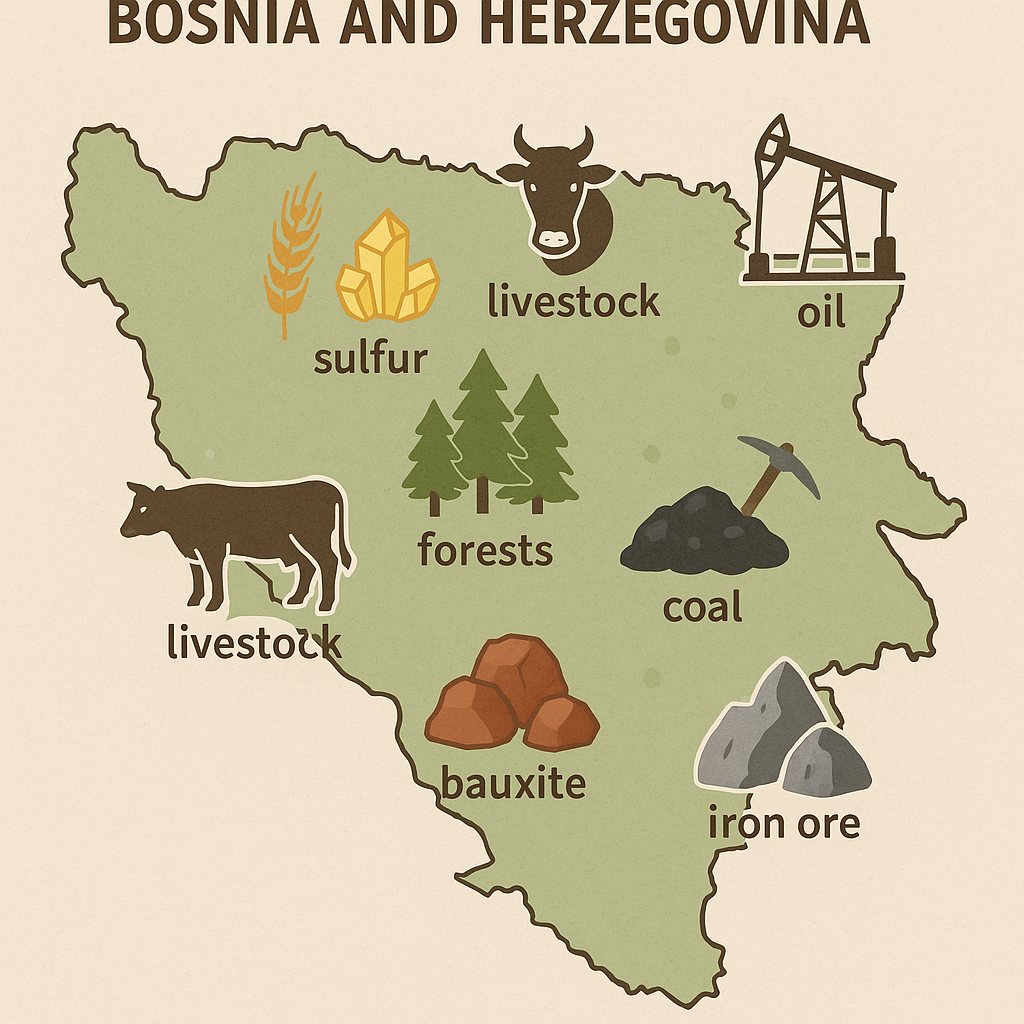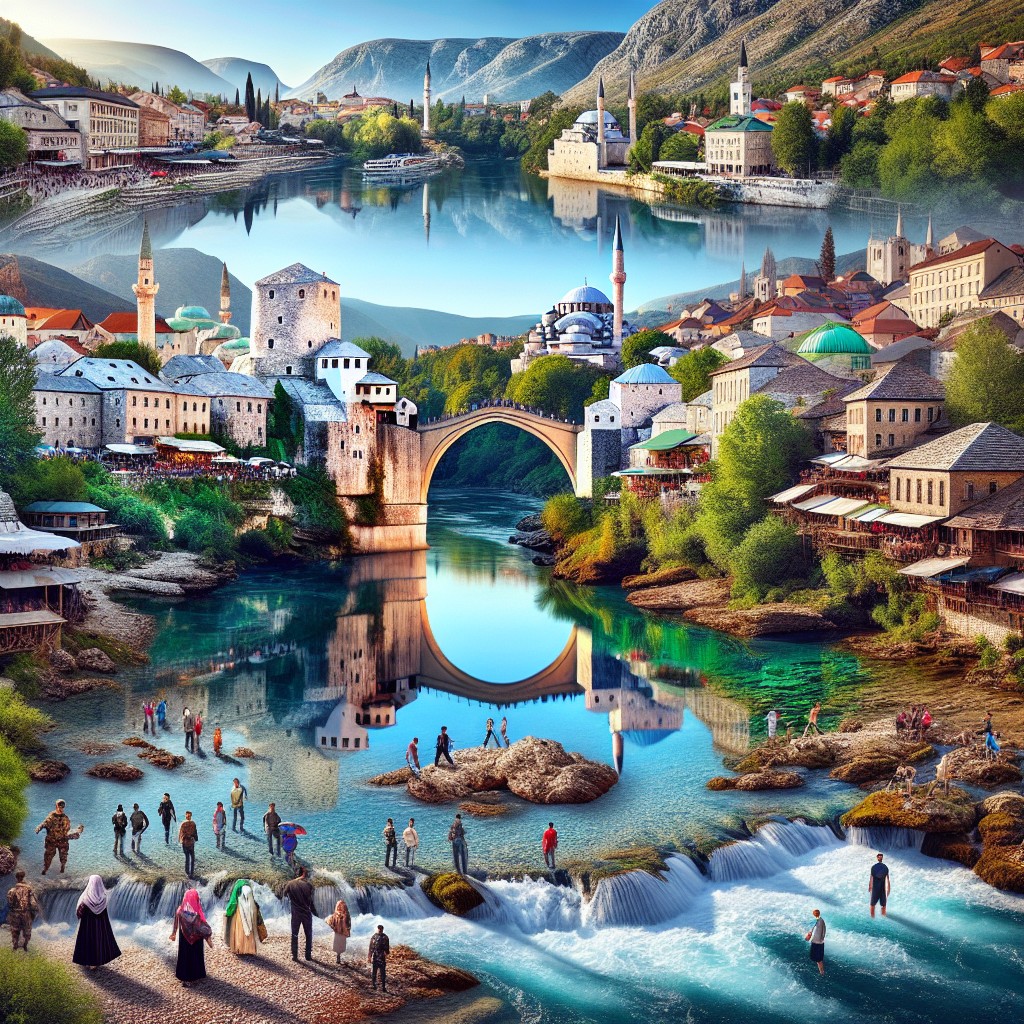Discover the Rich Natural Resources of Bosnia and Herzegovina
Explore the geography, minerals, forests, and waters that power Bosnia and Herzegovina’s economy
Bosnia and Herzegovina, located in Southeastern Europe, is a country blessed with a wealth of natural resources. From its expansive forests and fertile lands to valuable minerals and water systems, Bosnia and Herzegovina’s geography has shaped its economic development, cultural legacy, and geopolitical importance. This article explores the natural resources of Bosnia, examines their role in the economy of Bosnia and Herzegovina, and highlights how resource management continues to influence both environmental sustainability and regional cooperation.
Whether you’re a student, researcher, or just curious about this fascinating country, this detailed overview will give you a strong understanding of the resources of Bosnia and Herzegovina, and why they matter in today’s global economy.
🧭 Article Outline
1. Where is Bosnia and Herzegovina Located and Why Is It Geographically Important?
2. What Are the Main Forest Resources in Bosnia and Herzegovina?
3. How Do Bosnia and Herzegovina’s Water Resources Fuel the Country?
4. Which Mineral Resources Drive Industrial Production in Bosnia and Herzegovina?
5. How Significant Are Bosnia’s Energy Resources for Its Economic Development?
6. What Role Does Coal Play in Energy in Bosnia and Herzegovina?
7. Are There Natural Gas Resources or Oil in Bosnia?
8. How Does Arable Land Contribute to the Agriculture Sector?
9. How Are the Natural Resources Distributed Between the Federation of Bosnia and Herzegovina and Republika Srpska?
10. What Challenges and Opportunities Lie Ahead for Bosnia and Herzegovina’s Resource Sector?
1. Where is Bosnia and Herzegovina Located and Why Is It Geographically Important?
Bosnia and Herzegovina is a country in Southeast Europe, situated on the western part of the Balkan Peninsula, bordered by Croatia, Serbia, and Montenegro. The geography of Bosnia and Herzegovina includes mountainous terrain, river valleys, and a short coastline along the Adriatic Sea.
The country’s position has made it a historical crossroad for cultures and trade. Bosnia occupies the northern part of the territory, while Herzegovina occupies the southern region. Its land area is approximately 51,000 square kilometers, with rich diversity in topography and natural systems, making it well-positioned for a resource-driven economy.
2. What Are the Main Forest Resources in Bosnia and Herzegovina?
The forest resources of Bosnia and Herzegovina are among the richest in Europe. Covering over 50% of the country’s total land area, these forests are vital for the economy of Bosnia and Herzegovina, especially in the wood processing and furniture industries.
Dense forests are mainly found in central Bosnia, eastern Bosnia, and parts of Bosnia and Herzegovina bordering Croatia and Serbia. The forests not only provide timber but also support biodiversity, act as carbon sinks, and protect against soil erosion. Sustainable forestry is essential to maintain this balance.
3. How Do Bosnia and Herzegovina’s Water Resources Fuel the Country?
Water resources in Bosnia and Herzegovina play a key role in the country’s energy and agricultural sectors. Major rivers like the Sava, Drina, and Neretva are crucial for hydropower production, irrigation, and fresh water supply.
The Sava River, which forms part of the northern border with Croatia, is one of the most important waterways. The Neretva River, flowing through Mostar, is renowned for its ecological significance. Hydropower is a major contributor to the country’s GDP, thanks to numerous power plants built along these rivers.
4. Which Mineral Resources Drive Industrial Production in Bosnia and Herzegovina?
The mineral resources of Bosnia and Herzegovina include coal, bauxite, iron ore, zinc, and manganese. These resources include coal, especially lignite and brown coal, found in regions like Tuzla and Zenica.
Bauxite is another significant resource, essential for the aluminum industry. The industrial production based on mining and processing these materials has long supported the economy of Bosnia and Herzegovina. The city of Srebrenica is also known for its historical mineral extraction activities, including zinc and manganese.
5. How Significant Are Bosnia’s Energy Resources for Its Economic Development?
Energy resources are critical for Bosnia and Herzegovina’s economy. The country has an abundance of coal, hydropower, and the potential for natural gas and renewables. Energy in Bosnia and Herzegovina is highly decentralized, with various power plants operating in both the Federation of Bosnia and Herzegovina and Republika Srpska.
Energy not only fuels domestic needs but is also exported to neighboring countries. This sector represents a growing opportunity for further investment and technological development, especially in renewable energy sources.
6. What Role Does Coal Play in Energy in Bosnia and Herzegovina?
Coal remains the cornerstone of Bosnia and Herzegovina’s energy production. Rich deposits of coal are primarily found in Tuzla, Zenica, and central Bosnia, forming the backbone of the country’s thermal power generation system.
Despite global shifts toward green energy, coal still provides energy security for Bosnia. However, environmental concerns and EU climate goals are pressuring the government to invest in cleaner alternatives. Nevertheless, coal currently dominates energy production due to its availability and affordability.
7. Are There Natural Gas Resources or Oil in Bosnia?
Natural gas resources in Bosnia and Herzegovina remain largely untapped, though exploration continues. Geological surveys have indicated that oil deposits might exist, but the exact quantities of oil are uncertain. These resources, if confirmed and developed, could provide long-term benefits for economic development.
Today, most natural gas is imported via pipelines from Serbia and other neighbors. The development of natural gas resources is seen as a strategic step for diversifying energy in Bosnia and Herzegovina and reducing dependence on foreign supplies.
8. How Does Arable Land Contribute to the Agriculture Sector?
Bosnia and Herzegovina has significant areas of arable land, especially fertile soils found along the valley of rivers, such as the Sava and Drina. These lands support crops such as wheat, corn, vegetables, and fruits.
The agriculture sector in Bosnia and Herzegovina benefits from favorable climates and fertile valleys, contributing to food security and rural employment. Agricultural activities are important for many people living in Bosnia, especially in rural areas.
9. How Are the Natural Resources Distributed Between the Federation of Bosnia and Herzegovina and Republika Srpska?
Under the Dayton Accords of 1995, Bosnia and Herzegovina was divided into two political entities: the Federation of Bosnia and Herzegovina and Republika Srpska. This division affects the management and exploitation of resources in Bosnia and Herzegovina.
The federation of Bosnia and Herzegovina controls many of the mineral-rich areas like Tuzla and Zenica, while Republika Srpska, home to cities like Banja Luka, also has extensive forest and water resources. Shared coordination is required through the national government for balanced and equitable development.
10. What Challenges and Opportunities Lie Ahead for Bosnia and Herzegovina’s Resource Sector?
The development of natural resources faces several challenges. These include outdated technology, lack of investment, and political divisions between Bosnian Serb and Bosnian Croat factions. Additionally, the war in Bosnia and Herzegovina left parts of the country with damaged infrastructure, making it harder to rebuild industries.
On the flip side, Bosnia and Herzegovina’s rich natural resources offer opportunities for growth in green energy, tourism, and sustainable forestry. Improved cooperation, EU integration, and climate-conscious policies could unlock the full potential of the natural resources of Bosnia.
🔚 Key Takeaways
-
Bosnia and Herzegovina is a country in Southeast Europe rich in forests, minerals, and rivers.
-
Major forest resources cover over 50% of the territory of Bosnia and Herzegovina, especially in central and eastern parts.
-
The Sava, Drina, and Neretva rivers are essential water resources supporting hydropower and agriculture.
-
Important mineral resources include coal, bauxite, iron ore, zinc, and manganese.
-
The country has potential in natural gas resources and possibly oil, although exploration is ongoing.
-
Tuzla, Zenica, Banja Luka, and Mostar are key industrial and energy hubs.
-
Agricultural output benefits from arable land and fertile soils, producing crops such as wheat.
-
The economy of Bosnia and Herzegovina depends heavily on natural resources, though modernization is needed.
-
The Federation of Bosnia and Herzegovina and Republika Srpska share and manage resources differently under the Dayton Accords.
-
The future of Bosnia and Herzegovina’s economy hinges on sustainable development, regional cooperation, and EU-oriented reforms.
Mineral Resources in Bosnia and Herzegovina
Bosnia and Herzegovina is known for its abundant mineral resources. The mining industry has played a significant role in the country’s economy for centuries. The mineral deposits in Bosnia and Herzegovina include coal, iron ore, bauxite, lead, zinc, copper, and gold. These minerals are essential for various industries such as construction, manufacturing, and energy production.
The mining sector contributes significantly to the country’s GDP and provides employment opportunities for many people. It also attracts foreign investments and contributes to the overall economic growth of the country. For example, the coal mines in Bosnia and Herzegovina are crucial for the production of electricity and heating. The iron ore deposits are used in steel production, while bauxite is used in the production of aluminum.
Forest Resources in Bosnia and Herzegovina
Forests cover a significant portion of Bosnia and Herzegovina’s land area. They play a vital role in the country’s economy and environment. The forests provide timber for construction, furniture production, and paper manufacturing industries. They also contribute to the tourism sector by attracting visitors who enjoy hiking, camping, and wildlife observation.
The forest resources in Bosnia and Herzegovina consist of various tree species such as beech, oak, pine, spruce, fir, and maple. These trees provide habitat for numerous plant and animal species, contributing to the biodiversity of the country. The forests also help in regulating the climate by absorbing carbon dioxide and releasing oxygen.
Agricultural Resources in Bosnia and Herzegovina
Agriculture is an essential sector in Bosnia and Herzegovina’s economy. The fertile plains and favorable climate provide suitable conditions for crop cultivation and livestock rearing. The agricultural resources in the country include arable land, pastures, and water bodies for irrigation.
The agricultural sector contributes to food security by producing a variety of crops such as wheat, corn, barley, potatoes, fruits, and vegetables. Livestock farming is also prevalent, with cattle, sheep, pigs, and poultry being raised for meat and dairy products. The agricultural sector provides employment opportunities for many people, especially in rural areas.
Water Resources in Bosnia and Herzegovina
Bosnia and Herzegovina is blessed with abundant water resources. The country is home to numerous rivers, lakes, and underground water sources. These water bodies play a crucial role in the country’s economy and environment.
The rivers in Bosnia and Herzegovina are used for transportation, irrigation, and hydropower generation. The country has several hydroelectric power plants that produce a significant portion of its electricity needs. The lakes provide opportunities for fishing, tourism, and recreational activities.
Energy Resources in Bosnia and Herzegovina
Energy resources are vital for the development of any country. Bosnia and Herzegovina have diverse energy sources that contribute to its energy security and economic growth. These energy resources include coal, natural gas, oil, hydropower, and geothermal energy.
Coal is the primary source of energy in Bosnia and Herzegovina. The country has significant coal reserves that are used for electricity generation and heating purposes. Hydropower is another important source of energy, with many hydroelectric power plants located along the rivers.
Natural Gas Resources in Bosnia and Herzegovina
Bosnia and Herzegovina has significant natural gas reserves, which contribute to its energy mix. Natural gas is used for heating, electricity generation, and industrial processes. The country has several natural gas fields, including the Semberija field and the Posavina field.
Natural gas is considered a cleaner alternative to coal and oil, as it produces fewer greenhouse gas emissions. It is also a more efficient source of energy. The development of natural gas resources in Bosnia and Herzegovina can help reduce the country’s dependence on imported energy sources.
Oil Resources in Bosnia and Herzegovina
Bosnia and Herzegovina has limited oil reserves compared to other countries in the region. However, oil exploration and production activities are still carried out in the country. The oil fields in Bosnia and Herzegovina include the Dinarides field and the Pannonian Basin.
Oil is an essential energy source for transportation, industrial processes, and power generation. The development of oil resources in Bosnia and Herzegovina can help reduce the country’s dependence on imported oil and increase its energy security.
Geothermal Resources in Bosnia and Herzegovina
Bosnia and Herzegovina has significant geothermal resources that have the potential for energy production. Geothermal energy is derived from the heat stored beneath the Earth’s surface. It can be used for heating, electricity generation, and other industrial processes.
The geothermal sites in Bosnia and Herzegovina include the Tuzla Basin, which has high-temperature geothermal reservoirs. The development of geothermal energy can help diversify the country’s energy sources and reduce its dependence on fossil fuels.
The Importance of Managing Bosnia and Herzegovina’s Natural Resources
In conclusion, Bosnia and Herzegovina’s natural resources are crucial for its economy, environment, and overall development. The responsible management of these resources is essential to ensure their sustainability and long-term benefits. It is important to strike a balance between economic development and environmental conservation.
The government and relevant stakeholders should implement policies and practices that promote sustainable use of natural resources. This includes proper land management, reforestation, water conservation, and the adoption of clean energy sources. By managing its natural resources responsibly, Bosnia and Herzegovina can ensure a prosperous future for its people and protect its unique environment.
FAQs
What are the natural resources of Bosnia and Herzegovina?
Bosnia and Herzegovina is rich in natural resources such as coal, iron ore, bauxite, copper, lead, zinc, timber, and arable land.
Where is coal found in Bosnia and Herzegovina?
Coal is found in several locations in Bosnia and Herzegovina, including the Kakanj and Zenica basins, the Breza and Vares fields, and the Banovici basin.
What is the status of iron ore mining in Bosnia and Herzegovina?
Iron ore mining in Bosnia and Herzegovina has a long history and is still an important industry. The largest iron ore mine is located in the Kakanj basin, and other significant deposits are found in the Vares and Ljubija fields.
Where is bauxite found in Bosnia and Herzegovina?
Bauxite is found in the central and eastern parts of Bosnia and Herzegovina, particularly in the Zenica-Doboj Canton and the Tuzla Canton.
What is the significance of copper mining in Bosnia and Herzegovina?
Copper mining has been an important industry in Bosnia and Herzegovina for centuries. The largest copper mine is located in the town of Borci, and other significant deposits are found in the Visegrad and Kladanj areas.
Where are the lead and zinc deposits located in Bosnia and Herzegovina?
Lead and zinc deposits are found in several locations in Bosnia and Herzegovina, including the Srebrenica and Olovo areas, as well as the Kakanj and Zenica basins.
What is the extent of timber resources in Bosnia and Herzegovina?
Bosnia and Herzegovina has significant timber resources, with forests covering over 50% of the country’s land area. The most common tree species include beech, oak, and fir.
Where is arable land located in Bosnia and Herzegovina?
Arable land is found throughout Bosnia and Herzegovina, particularly in the river valleys and lowland areas. The most fertile regions are located in the north and northeast of the country.



